|
 |
|
page: 1 | 2 | 3 | 4 | 5 | 6 | 7 | 8 | 9
|
|
|
After climbing Licancabur I spend an easy day reading in the sun in front of the huts at Laguna Verde. In the afternoon I join a group to hot springs at 4.500 m and then take the bus back to San Pedro.
|
|
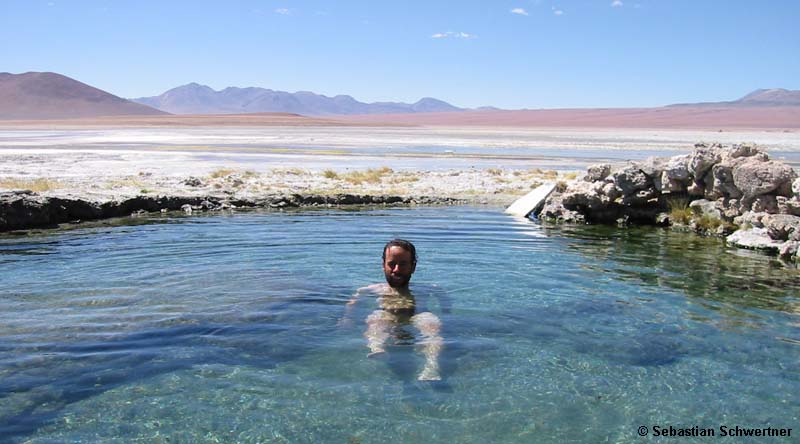 |
|
|
Thermal pool
|
|
|
In town I meet Steffen Welsch, a German mountain guide who moved here with his Chilean wife. He lives at the edge of the oasis in a beautiful house. We agree to climb Llullaillaco (6.739 m) the sacred mountain of the Incas together.
|
|
|
|
|
|
House of Steffen Welsch
|
|
|
We spend the next two days shopping and load his Toyota Hilux with two barrels of water and diesel. From San Pedro we head south along the white vastness of the Salar de Atacama. This used to be the ocean floor that was lifted by tectonic forces. The resulting lake fell dry and now the ground is covered with salt. On some spots water comes through the salt creating turquoise holes resembling eyes. It´s a fascinating and unreal landscape with one of the world´s largest lithium mines at the southern end.
|
|
|
|
|
|
|
|
|
We cross the Salar on a dead flat salt road. But the next Salar is not far away. Salar de Punta Negra is much smaller, but surrounded by green salt-resistent grasses. From here unmarked tracks lead to the Llullaillaco National Park. We take a wrong turn and are stuck in soft sand within 30 minutes. No one seems to have been to this remote park for years. We fill up water at a pump for the Escondida mine.
|
|
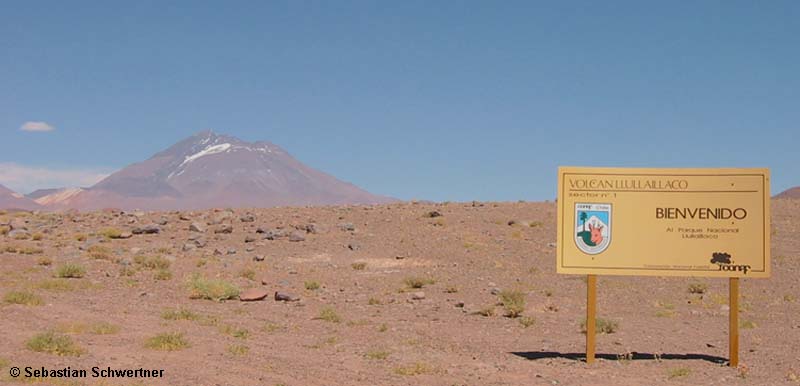 |
|
|
Llullaillaco (6.739 m)
|
|
|
In the last light we arrive at the Llullaillaco hut and are surprised to meet a whole company of the Chilean army. But they give us a friendly reception and invite us to dinner. The meal is tasty and I eat quite a lot. At night I can´t sleep with a full belly. So we have an early start around the mountain to its western slope.
|
|
|
|
|
|
Llullaillaco National Park
|
|
|
|
|
|
|
|
|
At 5.100 m the Hilux yields on the steepening slope. So we pack our bags and start climbing. We pass four to five meter tall snow penitents and hardened lava streams that are several kilometers long. In the evening we set up our tent in a small sheltered recess at 6.100 m. The only lights in the distance are from the Escondida mine. Even inside the tent the temperatures are dropping fast. We cook some tea, but eat only little. I´m not hungry at all and I´m not sleeping well, my sleeping bag is just not warm enough at -15°C. In the morning getting out of the sleeping bag is hard. My hands and feet are cold. So at 6.300 m we decide to turn around. I don´t want to risk any frostbites, even when the summit is only three hours away.
|
|
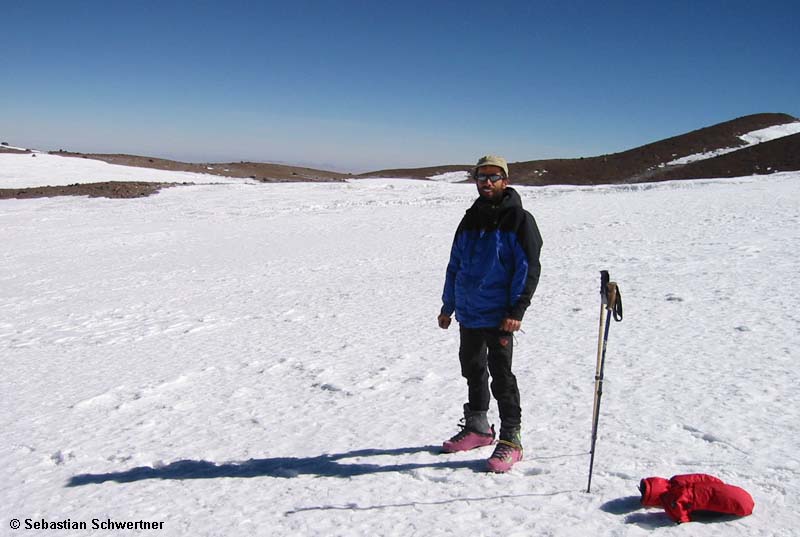 |
|
|
Frozen lake at 6.300 m
|
|
|
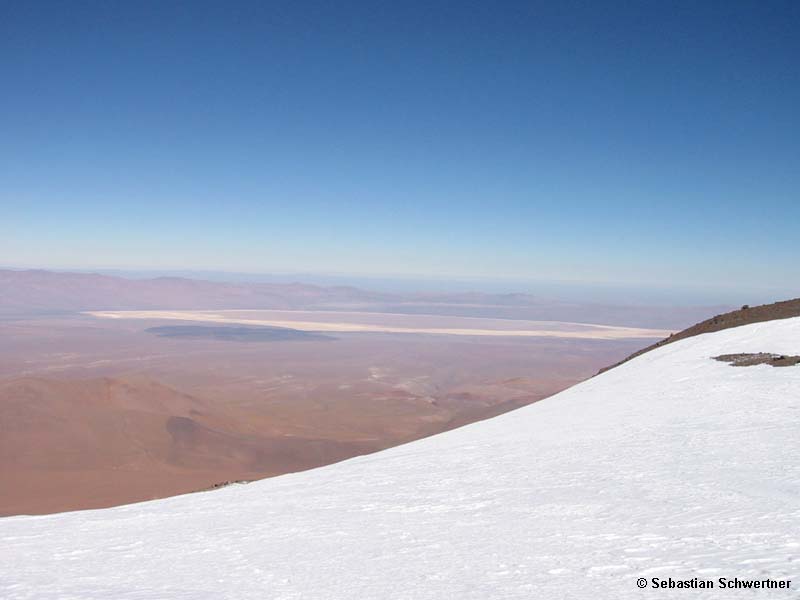
|
|
|
View from Llallaillaco to the Salar de Punta Negra
|
|
|
Within 30 minutes we are back at the tent and two hours later we are at the car. After a quick drive we arrive back in San Pedro at dusk. For the following days I book a tour with Colque Tours to Uyuni and spend the last evening in Chile with friends in a pub until late at night.
|
|
|
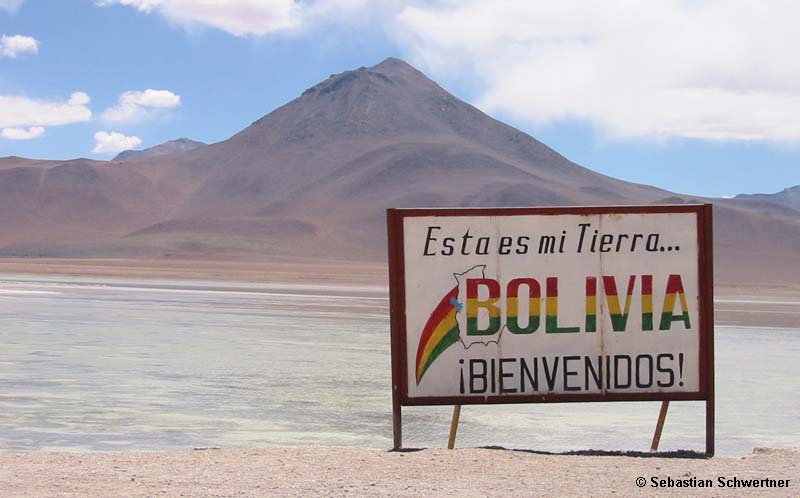
|
|
|
Laguna Verde (Bolivia)
|
|
|
So its back with the bus over the Bolivian border to the Laguna Verde. Here my bicycle is loaded onto a truck to Uyuni while I cram into an old Toyota Landcruiser with four other travellers to the Salar de Uyuni. This is high desert country, we pass colourful lakes with thousands of flamingos, and more geyser fields, these are even higher in elevation than those in Chile. At the highest point we are hit by summer rain. The clouds are coming from the east from the Amazon basin over the Bolivian plateau. We are standing at 5.300 m in thick mist and it starts snowing. The ground is steaming and from dark holes foul-smelling mud is bubbling wildly. It´s an unreal surrounding and a lifeless world up here. The tracks get very muddy and sandy. No one lives in the south-western part of Bolivia. We stop at Laguna Colorada in one of Colque´s own bases for the night. These huts are 100 and more km apart. None of the roads are on a map and there are no signs. But the driver seems to know every bump in the road.
|
|
|
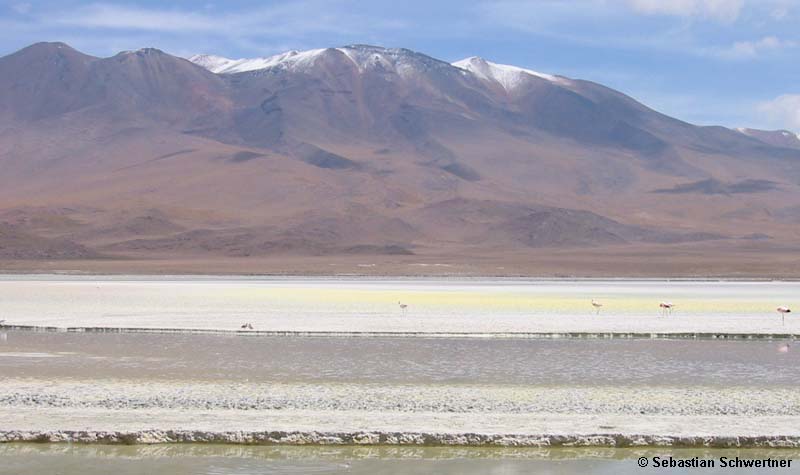
|
|
|
Laguna Colorada
|
|
| The second day dawns with bright skies and we leave the Lagunas north on deep sandy tracks. The landscape is surreal and could be straight out of a Salvador Dali painting. We stop for lunch at the only tree around the sandstone formation called Abre del Pietra. On the way to San Jose we get almost stuck in salty swamps, because the four wheel drive of the ageing Landcruiser quit long time ago.
|
|
|
|
|
|
|
|
| We spend the night in Chuvica, a very small village on the western shore of the Salar de Uyuni. Colque has a new guesthouse there, which even has table tennis. I haven´t played this for years. And it´s great fun at 3.670 m, almost everyone else seems to be running out of breath quickly.
|
|
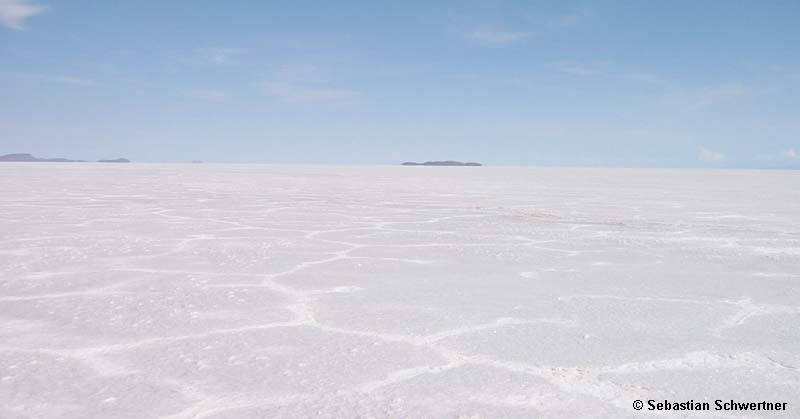 |
|
|
Salar de Uyuni
|
|
| The Salar de Uyuni is 12.000 square kms. It´s one of the world biggest salt lakes and at an elevation of 3.653 m one the most cruel too. The salt layers are up to 30 m thick and carry cars and trucks without any problem. From the flat salt surface islands rise like on a “normal” lake. We stop at the Isla del Incahuasi for lunch between 12 m tall cacti.
|
|
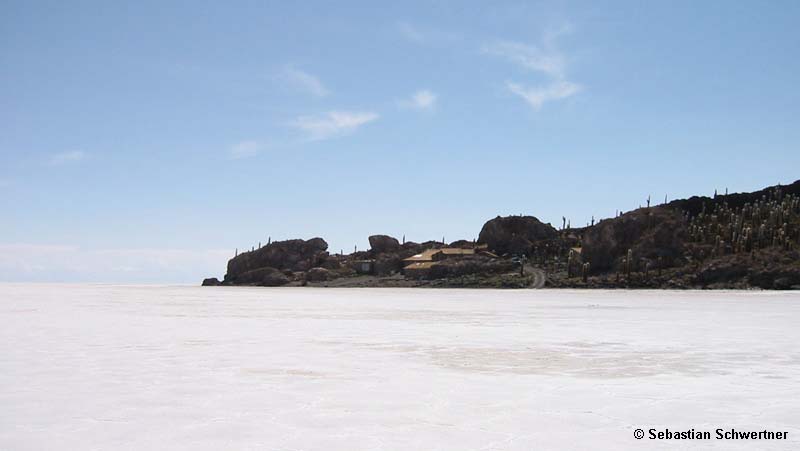 |
|
|
Isla del Incahuasi
|
|
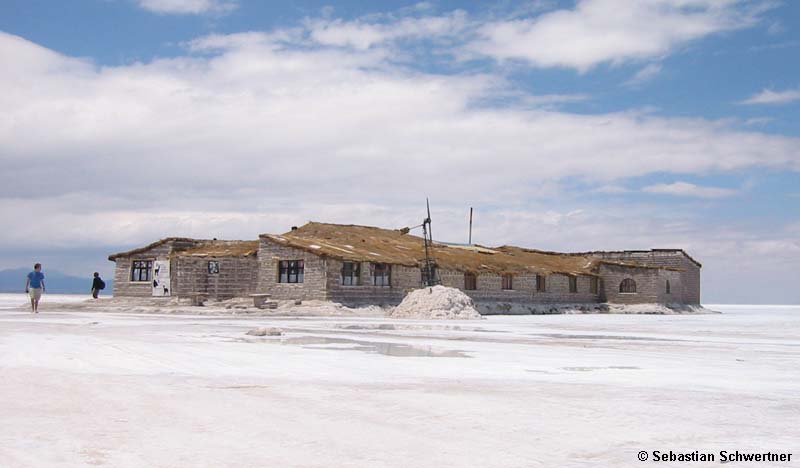 |
|
|
Hotel made of salt
|
|
| It´s rainy season in March and the whole eastern part of the Salar is flooded with water. Driving through 10 cm of salt saturated water leaves visible marks on the Landcruiser, crossing this on a bicycle would be impossible.
|
|
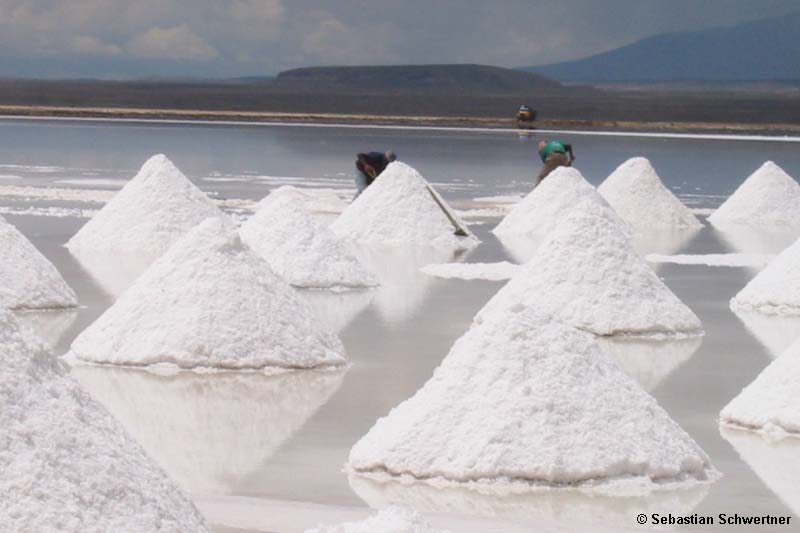 |
|
|
Salt mining
|
|
| In the evening we arrive at Uyuni, a small town on the Altiplano with electricity only between 5 and 10 p.m. It´s market day and the streets are booming with live. But I like to carry on and manage to get a seat on the night bus to La Paz.
|
|
 |
|
|
Uyuni
|
|
| Bus rides in Bolivia are different from Chile (and the rest of the world for that matter). The bus is from the late 1960s and can drive through three feet of water. The road to La Paz is flooded most of the way and the bus swims slowly through the night. There is a stop in a small village and everyone gets out to refresh and buy something to drink or eat. When the bus driver is finished he honks and starts driving leaving some screaming passengers behind. The bus takes seven hours for 190 km to Oruro. And I´m happy to be on the bus and not riding my bicycle.
Early in the morning I´m in La Paz, the capital of Bolivia. There are road blocks everywhere and armed police are patrolling in the streets. The week before there were shootings when police and army forces collided in downtown La Paz. Tension is in the air, but it remain quiet. On the main road mothers are demonstrating, searching for their deported husbands and sons. I move downtown into a modern hotel, my room is on the 5th floor. From here the view is great. The city is built onto the steep hill. El Alto and the airport are at 4.050 m and the motorway leads downhill for more than 1.000 m to the eastern end of the city.
I use the day to explore the city and do a little bit of shopping. Which isn´t easy, because markets are divided by goods and I have to find the right market first.
|
|
|
page: 1 | 2 | 3 | 4 | 5 | 6 | 7 | 8 | 9
|
|

